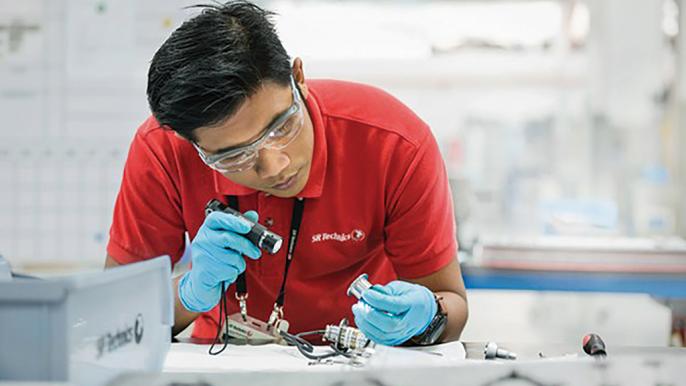
Over the past decade, the dominant trend in airline fleet strategy has been toward larger narrowbody aircraft. Meanwhile, aircraft manufacturers have extended the range of their single-aisle lines, opening the door for low-cost and other carriers to pursue more distant markets and longer, thinner routes than in the past.
Norwegian’s transatlantic services are a prime example, and while that airline’s finances remain somewhat precarious, other carriers are following in its wake. JetBlue Airways, for instance, intends to launch transatlantic flights with Airbus A321neo aircraft. As this market develops, it will affect where MRO is done.
Base Maintenance
To date, narrowbody base maintenance has been confined largely to the home regions or continents of their operators, with U.S. carriers very unlikely to choose European hangars and vice-versa. On the other hand, “widebody maintenance will occur anywhere globally, determined primarily by labor costs,” says Brian Sartain, senior vice president of repair and engineering services for AAR.
The primarily regional market for narrowbody heavy checks mainly is a function of the cost of ferry flights, a desire to coordinate maintenance locations with short-to-medium-haul networks and schedules and, in some cases, the range of the aircraft themselves.
“We expect the narrowbody market to stay largely unchanged in terms of where maintenance is provided due to the route structure of the airlines remaining largely stable,” says Sartain.
Conor O’Regan, vice president of sales for Europe at SR Technics, backs up this point. “Ferry flight and equipment costs up to mid-distance MRO facilities are economical, but ferrying narrowbody aircraft toward the limits of their range to secure lower-cost maintenance becomes much less economical.”
SR Technics is building a narrowbody maintenance facility with a six-bay hangar in Malta, well-located to attract customers from Europe, the Middle East and Africa, as well as “from farther afield for lease transitions,” says O’Regan.
Vilnius, Lithuania-based FL Technics usually attracts narrowbody customers within a 3-hr. flying time, but this can extend up to 7 hr. during busy periods, says CEO Zilvinas Lapinskas. “Slots in the maintenance season are scarce, which has led to us attracting clients from farther afield,” he says.
This important point, echoed by other maintenance providers, illustrates how the choice of MRO provider is not always dictated solely by price, quality, turnaround time and proximity, but also by what capacity is available.
“Increasingly limited MRO capacity sometimes is forcing customers to book slots well in advance with more local regional providers to avoid having to travel longer distances to secure maintenance slots,” says O’Regan.
However, an opposing dynamic is that newer-generation narrowbodies often require fewer maintenance manhours and allow longer intervals. “Thus flying longer ranges for maintenance events is less likely to be cost-effective for customers,” he says.

The situation is very different for widebodies, for which global route networks and longer turnaround times mean airlines have a far more geographically diverse choice of maintenance providers.
“With an influx of low-cost, widebody maintenance providers in Asia entering the MRO market over the last 10 years, we have seen an increase in MRO activity in the APAC region,” observes Sartain.
That said, there is some evidence that Western airlines are bringing widebody heavy maintenance back closer to home as the labor cost advantages of Asian providers continue to erode.
Line Maintenance
The nature of line maintenance means it needs to be performed close to the customer, although several MRO companies have expanded their reach in this field by establishing facilities in new markets or by buying foreign providers. Most also offer roving aircraft-on-ground (AOG) and mobile maintenance teams, which give them a wider geographical footprint.
“Providing [line and base maintenance] allows SR Technics maintenance teams to appreciate the importance of an effective recovery of an AOG event for one of our customers and demonstrates the quality of our services to more distant customers, encouraging them to consider our Malta facility for heavy maintenance business,” says O’Regan.
Lapinskas agrees that mobile teams allow an MRO provider to demonstrate its abilities to a wider array of customers, although it is difficult to draw a direct link between mobile teams and subsequent heavy maintenance contracts.
Component and Engine Maintenance
“Component shops can attract repair volumes from more distant customers, where the MRO has regular and efficient trade lanes established intra-regionally, coupled with competitive and reliable turnaround times,” says O’Regan.
Sartain notes that component maintenance is usually restricted to an airline’s home operating region, although exceptions are made for items such as gearboxes and APUs, for which he says there is a “global market.”
One trend encouraging this has been the development of pooling programs, in which participating airlines draw a replacement part from a nearby distribution center and send off the old part for repair anywhere in the world before it returns to the pool.
Most MRO providers agree that the market for engine repairs is worldwide, with O’Regan citing a global customer base from all continents for SR Technics’ CFM56 and PW4000 maintenance services at its Zurich engine center.
Lapinskas agrees: “Engine maintenance depends on the scope of the work that needs to be done—minor repairs could be within truck-driving distance of the mechanic performing on- or near-wing maintenance. Major work is not that sensitive to transportation costs; availability, timing, turnaround time and quality are the main factors.”
Again, these days an important factor is availability. For while newer, longer-range aircraft and the spread of long-haul, low-cost carriers might not be redrawing the boundaries of the maintenance market just yet, the availability of hangar and workshop slots is likely to push some carriers into the arms of more distant providers.
